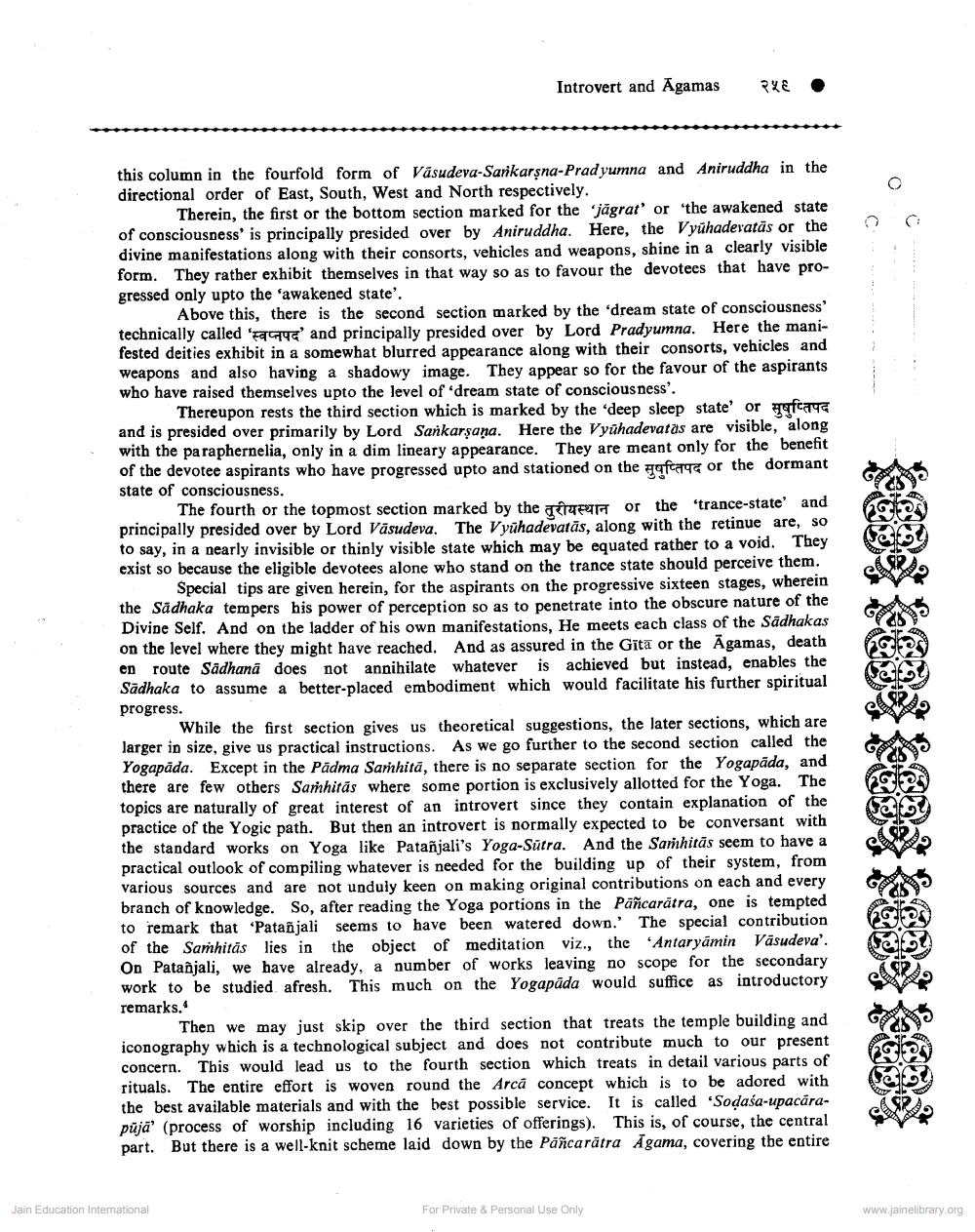________________ Introvert and Agamas 256 . this column in the fourfold form of Vasudeva-Sarikarsna-Pradyumna and Aniruddha in the directional order of East, South, West and North respectively. Therein, the first or the bottom section marked for the jagrat' or 'the awakened state of consciousness' is principally presided over by Aniruddha. Here, the Vyuhaderatas or the divine manifestations along with their consorts, vehicles and weapons, shine in a clearly visible form. They rather exhibit themselves in that way so as to favour the devotees that have progressed only upto the 'awakened state'. Above this, there is the second section marked by the dream state of consciousness' technically called 'Fanny' and principally presided over by Lord Pradyumna. Here the manifested deities exhibit in a somewhat blurred appearance along with their consorts, vehicles and weapons and also having a shadowy image. They appear so for the favour of the aspirants who have raised themselves upto the level of 'dream state of consciousness'. Thereupon rests the third section which is marked by the deep sleep state' or Aercaya and is presided over primarily by Lord Sarkarsana. Here the Vyuhadevatas are visible, along with the paraphernelia, only in a dim lineary appearance. They are meant only for the benefit of the devotee aspirants who have progressed upto and stationed on the office or the dormant state of consciousness. The fourth or the topmost section marked by the NETG or the 'trance-state' and principally presided over by Lord Vasudeva. The Vyuhadevatas, along with the retinue are, so to say, in a nearly invisible or thinly visible state which may be equated rather to a void. They exist so because the eligible devotees alone who stand on the trance state should perceive them. Special tips are given herein, for the aspirants on the progressive sixteen stages, wherein the Sadhaka tempers his power of perception so as to penetrate into the obscure nature of the Divine Self. And on the ladder of his own manifestations, He meets each class of the Sadhakas on the level where they might have reached. And as assured in the Gita or the Agamas, death en route Sadhana does not annihilate whatever is achieved but instead, enables the Sadhaka to assume a better-placed embodiment which would facilitate his further spiritual progress. While the first section gives us theoretical suggestions, the later sections, which are larger in size, give us practical instructions. As we go further to the second section called the Yogapada. Except in the Padma Samhita, there is no separate section for the Yogapada, and there are few others Samhitas where some portion is exclusively allotted for the Yoga. The topics are naturally of great interest of an introvert since they contain explanation of the practice of the Yogic path. But then an introvert is normally expected to be conversant with the standard works on Yoga like Patanjali's Yoga-Sutra. And the Samhitas seem to have a practical outlook of compiling whatever is needed for the building up of their system, from various sources and are not unduly keen on making original contributions on each and every branch of knowledge. So, after reading the Yoga portions in the Pancaratra, one is tempted to remark that "Patanjali seems to have been watered down.' The special contribution of the Samhitas lies in the object of meditation viz., the "Antaryamin Vasudeva'. On Patanjali, we have already, a number of works leaving no scope for the secondary work to be studied, afresh. This much on the Yogapada would suffice as introductory remarks. Then we may just skip over the third section that treats the temple building and iconography which is a technological subject and does not contribute much to our present concern. This would lead us to the fourth section which treats in detail various parts of rituals. The entire effort is woven round the Arca concept which is to be adored with the best available materials and with the best possible service. It is called "Sodasa-upacara. puja (process of worship including 16 varieties of offerings). This is, of course, the central part. But there is a well-knit scheme laid down by the Pancaratra Agama, covering the entire SUTI AUTOS Jain Education International For Private & Personal Use Only www.jainelibrary.org




